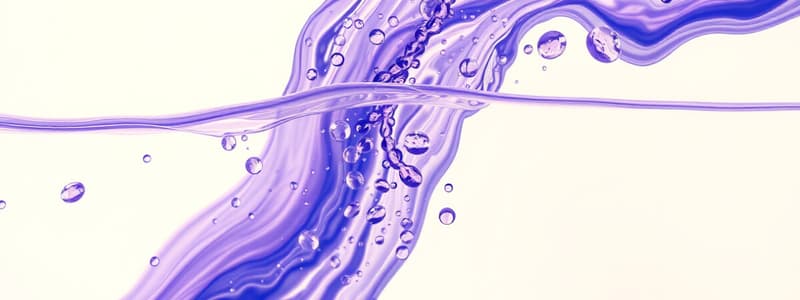Podcast
Questions and Answers
What is hydrostatic pressure?
What is hydrostatic pressure?
The pressure that the fluid exerts on the walls of its container.
What is osmotic pressure?
What is osmotic pressure?
The pressure required to prevent the flow of water across a semipermeable membrane via osmosis.
What is the main cause of hydrostatic pressure in the cardiovascular system?
What is the main cause of hydrostatic pressure in the cardiovascular system?
The force of blood on the blood vessel walls.
What is the main cause of osmotic pressure in the cardiovascular system?
What is the main cause of osmotic pressure in the cardiovascular system?
Hydrostatic pressure in the blood is (______, less than, the same as) hydrostatic pressure in the interstitial fluid.
Hydrostatic pressure in the blood is (______, less than, the same as) hydrostatic pressure in the interstitial fluid.
Osmotic pressure in the blood is (______, less than, the same as) osmotic pressure in the interstitial fluid.
Osmotic pressure in the blood is (______, less than, the same as) osmotic pressure in the interstitial fluid.
Hydrostatic pressure of the blood at the arteriole end of a capillary is (______, less than, the same as) hydrostatic pressure of the blood at the venule end of a capillary.
Hydrostatic pressure of the blood at the arteriole end of a capillary is (______, less than, the same as) hydrostatic pressure of the blood at the venule end of a capillary.
Osmotic pressure of the blood at the arteriole end of a capillary is (higher than, ______, the same as) osmotic pressure of blood at the venule end of a capillary.
Osmotic pressure of the blood at the arteriole end of a capillary is (higher than, ______, the same as) osmotic pressure of blood at the venule end of a capillary.
Hydrostatic pressure of the interstitial fluid at the arteriole end of a capillary is (higher than, less than, the ______) hydrostatic pressure of the interstitial fluid at the venule end of a capillary.
Hydrostatic pressure of the interstitial fluid at the arteriole end of a capillary is (higher than, less than, the ______) hydrostatic pressure of the interstitial fluid at the venule end of a capillary.
Osmotic pressure of the interstitial fluid at the arteriole end of a capillary is (higher than, less than, the ______) osmotic pressure of the interstitial fluid at the venule end of a capillary.
Osmotic pressure of the interstitial fluid at the arteriole end of a capillary is (higher than, less than, the ______) osmotic pressure of the interstitial fluid at the venule end of a capillary.
At the arterial end of a capillary, hydrostatic pressure of the blood is (______, less than, the same as) osmotic pressure of the interstitial fluid.
At the arterial end of a capillary, hydrostatic pressure of the blood is (______, less than, the same as) osmotic pressure of the interstitial fluid.
At the venule end of a capillary, hydrostatic pressure of the blood is (higher than, ______, the same as) osmotic pressure of the interstitial fluid.
At the venule end of a capillary, hydrostatic pressure of the blood is (higher than, ______, the same as) osmotic pressure of the interstitial fluid.
At the arteriole end of a capillary, osmotic pressure of the blood is (______, less than, the same as) hydrostatic pressure of the interstitial fluid.
At the arteriole end of a capillary, osmotic pressure of the blood is (______, less than, the same as) hydrostatic pressure of the interstitial fluid.
At the venule end of a capillary, osmotic pressure of the blood is (______, less than, the same as) hydrostatic pressure of the interstitial fluid.
At the venule end of a capillary, osmotic pressure of the blood is (______, less than, the same as) hydrostatic pressure of the interstitial fluid.
Flashcards are hidden until you start studying
Study Notes
Hydrostatic Pressure
- Hydrostatic pressure refers to the force exerted by a fluid against the walls of its container.
- In the cardiovascular system, hydrostatic pressure is primarily caused by the force of blood on blood vessel walls.
- Blood hydrostatic pressure at the arteriole end of a capillary is higher than at the venule end.
- Hydrostatic pressure in the blood is greater than that in the interstitial fluid.
Osmotic Pressure
- Osmotic pressure is defined as the pressure needed to prevent water flow across a semipermeable membrane during osmosis.
- In the cardiovascular system, osmotic pressure arises from the diffusion of water from a hypotonic to a hypertonic solution.
- Osmotic pressure in the blood is higher than that in the interstitial fluid.
Comparison of Pressure in Capillaries
- At the arteriole end of a capillary, the blood's hydrostatic pressure exceeds that of the blood at the venule end.
- Osmotic pressure of blood at the venule end is less than that at the arteriole end due to changes in hydrostatic pressure.
- Hydrostatic pressure in interstitial fluid remains the same at both arteriole and venule ends of the capillary.
- Osmotic pressure in interstitial fluid is also consistent at the arteriole and venule ends.
Pressure Relationships
- At the arterial end of a capillary, blood hydrostatic pressure is higher than the osmotic pressure of the interstitial fluid.
- At the venule end of a capillary, blood hydrostatic pressure is less than the osmotic pressure of the interstitial fluid.
- Blood osmotic pressure at the arteriole end is greater than the hydrostatic pressure of interstitial fluid.
- At the venule end, blood osmotic pressure remains higher than that of the interstitial fluid.
Studying That Suits You
Use AI to generate personalized quizzes and flashcards to suit your learning preferences.




